Medieval History

This is highly detailed article of the Hittites (or Hatti) specifically taken from a sociological perspective, as the true joy of reading about the Hittites comes from discovering their culture and the several cultures they interacted with. Featured in this article is an extensive history of Middle Egypt, Hittites from beginning to end, and Hurrians, all of whom are legendary cultures during the late Bronze Age. See them as they all interacted with the Hittites for centuries or longer, both in peace and in battle!
IN THE BEGINNING: The Hittites were a nomadic culture of Indo-Europeans who wandered (more like blundered) into ancient Mesopotamia around 1795 B.C. These people were essentially just a run-of-the-mill hunter-trader type of civilization. They mostly hunted, drank fish and traded some as they moved from place to place. It was around this time, however, that the nomadic way of life was truly at an end. Civilizations like ancient Sumer had gradually perfected a sedentary way of life outside of the Fertile Crescent long ago (some say as early as 3800 B.C. but most likely was around 2900 B.C.). Although it was difficult to survive in a sedentary lifestyle with primitive agriculture, people realized its advantages and kept working at it. The Hittites, however, were behind the times, so to speak, and were one of those cultures who saw the benefits of creating a village, but their story is unique in that they simply could not find a place to settle into. Their story is one of searching, struggle and irony.
THE HURRIANS: And yet, just as you'll see, the Hittites hit some bad luck on their way to Mesopotamia. They journeyed a couple thousand miles on foot (took several lifetimes of nomadic wandering) and when they saw the vast, lush beauty of Mesopotamia they knew they were home. However, Mesopotamia was occupied. The Hurrians controlled quite a vast territory since they arrived to a mostly empty Mesopotamia around 2000 B.C. They were like most of the other cultures around them in that they hunted, gathered, and drank like fish! However, they did not fully relinquish their nomadic ways, after all, they wanted the benefits of settlements and civilization but who said they had to be bored and give up their fun ways? Thus, the Hurrians as we know them now made their mark of the Bronze Age, and as you can clearly see from the map below, they had a massive territory that they felt was all theirs. They were the Bronze Age skull thumpers. They were mercenaries for hire to everyone around them just like Sarkhun of Akkad (Sargon) who so dashingly interrupted a Sumerian war around 2350s B.C. (350 years prior to Hurrians arriving) and promised to vanquish the Sumerian's enemies who continually bullied them. Funny thing, was that the civilization of Sumer weren't really being asked, since if they said no, Sarkhun would have killed them and their enemies and gotten what he wanted anyway. The Hurrians were almost identical in attitude and lifestyle. They forced the neighboring civilizations to hire them and protect them, or they'd simply make life really unpleasant. Naturally the Hurrians were accepted whether the nearby settlements wanted them there or not.
THE HITTITE STORY BEGINS: The Hurrians saw the Hittites wandering (more like blundering) in to their vast territory at around 1800 B.C. and immediately a huge clash of iron ensues. The Hittites really weren't any match for the Hurrian sword masters, so they were quite easily repelled and sent back north toward modern day Turkey. (On the map above, the Hittites came down from the northern area above the purple). This is when the Hittite story really begins. Repelled back from where they originally came and with their cultural pride wounded, the Hittites moved back north toward a friendly little village (map calls it Hattusa) settled next to a long river. These people are very nice, and it's such a good thing they are so kind to the Hittites, that way the Hittites can conquer them more easily! Only a couple weeks after being taken in by this generous mountain culture, these angry Hittites conquer the people, but chose soon afterward to drive them away.
The Hittites need to sit in time out... The Hittites proved to be no better than the Hurrians. They were so deeply embittered as a whole that the culture itself becomes despondent and isolative. However, the Hittites were the first culture to discover steel and they managed to learn how to fashion low-grade steel weapons. Against wrought iron, even low-grade steel would own the competition. But they brooded and pissed and moaned for an entire century inside their super-high, impenetrable walls about how terrible their luck was. The culture itself turned into a dark shroud to say the least. At about 1695 B.C., they finally become sick of feeling like chumps and make a hard march back down to where they last knew the Hurrians were and, as bad luck would have it, the Hurrians were even meaner and more bored than ever. It would seem that both sides were really itching for some action because the war that ensued was quite terrible.
The Hurrians were as tough as ever, they really hadn't changed much, but the mercenary needs of the Hurrians greatly dwindled over that century because all the Mesopotamian troublemakers just realized that they could win and just avoided the Hurrian territory altogether. This made the Hurrians tighten their grips harder around the neighboring civilizations with regards to "protecting" caravans and getting what was owed to them. They were, in essence, a band of thugs extracting protection money. But the Hittites didn't wander in, nor did they blunder in. They had spent the last century just getting angrier. The war was definitely fought well on both sides, and unlike when the Hittites blundered in to Hurrian territory in 1800 B.C., they knew a few things now and even had superior weapons made of low-grade steel. Luck was not with them yet again. The two cultures fought each other to a complete standstill when they realized both sides were dying evenly and the end of the war would be the end for them both. The Hurrians are thought to have been quite surprised by the fury behind the rag-tag Hittite army. The Hurrians offered the Hittites the old city (ruins) of Babylon as a joke. The Hittites were desperate, and realizing they didn't want to go back to Hattusas, they figured what could be worse than their previous home? Babylon was far worse. These poor people were the first people known to ever have a civilization and agriculture. Because the ground in Sumer had no healthy soil due to the rivers flooding like every so often, they had to make complexly woven mats of reeds to lay over what little dirt and soil they collected just for the plants to take root without drowning or washing away-- a pain staking way of living.
-
The Hittites knew they were tricked and they pushed most everyone out of the better areas of Sumer, such as the capitol Akkad (Babylon), but they left shortly thereafter. This empty city allowed the Kassites to simply walk in and take these small places for their own after the Hittites left (Kassites are pre-Bedouins, some Kassites left later and called themselves the Bedouin/Amorites). The Hittites went back to Hattusas and decided never to make the mistake of ever leaving again, or hoping for a better life. This time, however, they did not leave for a long time. It wouldn't be until In the 14th century BC that the Hittite Kingdom would prosper as they had originally wished it to. Their future kingdom would span from Asia Minor (Turkey) to Sumer, which was very far away. Not only that, but they also took control of Syria all the way south to Ugarit. How did their luck suddenly change?
DEATH OF THE HURRIANS AND RISE OF THE HITTITES: The Hurrians are thought to have been slowly vanquished by other clashing peoples over a period of time. This slow-but-steady destruction is still thought to have been primarily carried out by the Assyrians located far north of the Sumerian cities. Assyrians are one of those cultures that seems to have been/incorporated many cultures. They simply went everywhere from Assyria to Babylon all the way to parts of the Jewish cultures and Egypt between the 9th through 5th centuries B.C.. It wouldn't be until later that the Assyrians would become the nefarious monsters that history knows them to be.
?
The Hurrians had their hands full. Well, the Hittites chose this time to come back out and as luck would have it they landed the final blows against the weakened Hurrians, and the Hurrian culture came to an abrupt end. The Hittites are attributed as the victors of Carchemish, Mitanni, Aleppo, and more. There was a lot of back and forth fighting, but in essence and for the sake of time, the Hittites swallowed up all their land as their own and the underdogs became power wolves. This marks the switch from the reign of the Middle Hittite Kingdom 1500s B.C. to the New Kingdom of the Hittites around 1400s til about 1180 B.C. some believe. So all the things that have happened probably happened slowly over time due to the evidence. So while the 1450s B.C. clearly shows that the Hittites almost had full control over Hurrian territory, evidence also shows that it was probably many small battles for some decades as they slowly moved into Hurrian lands, meeting resistance every so often and weak periods where the Hittites lost territory but then won it back, all depending on who was ruling them. This makes sense since the Hurrians never fully gave up their nomadic style of life, so their numbers were probably scattered all over their territory and could have easily developed pocket resistances all over the place. They were under Hittite control officially by 1400 B.C., where Hurrian remnants gathered in the Hurrian city Mitanni under King Mattiwaza, who was given some authority to rule while under Hittite control, similar to a governor.
-
The Hittites saw fit to preserve the Hurrians as military support because the of Assyrians ruled under King Ashur-uballit I around 1365 B.C. were encroaching on Hittite territory. As luck usually worked out for the Hittites, Ashur-uballit I attacked and managed to defeat Hurrian King Mattiwaza despite the attempts of Hittite king Suppiluliuma I to preserve the Hurrians as a buffer. The lands of the Mitanni and Hurrians were appropriated by Assyria, enabling it to encroach on Hittite territory near Asia Minor. Not far along the timeline, Assyrian king Adad-nirari I annexed Carchemish from the control of the Hittites, however events seem to pause after this, as if the Assyrians took a break from wearing out the Hittites.
EGYPT AND THE HITTITE ASSASSINATION CONSPIRACY: Around 1479, Thutmose III was supposed to become Pharaoh during Egypt's 18th Dynasty, however, his stepmother Hatshepsut (hat-schep-soot) seized the throne (or stepsister, still debated- they were too incestuous to accurately tell). She made Thutmose III commander of her armies. After being set up for the murder of his stepmother/stepsister's daughter, he was banished from Egypt. Hatshepsut probably would have killed him, but remember that all Pharaohs were like demi-gods-- humans endowed with the spirits of the gods who wanted to help rule the Earth. Murdering Thutmose III would have collapsed the entire Egyptian god-system because real gods don't die. During this time, the Egyptians believed that their gods (primarily Ra) could not protect or even see any worshipper outside of Egypt, and they also believed that if any Egyptian died outside of Egypt that their soul would never go to the afterlife, or worse even. Thutmose III left anyway. He took his entire army out of Egypt and conquered northward all the way up to lower Syria. It took about 22 years, during which his step mother/sister eventually passed away, allowing him to return. Thutmose III ushered in the greatest era in Egyptian history, where their xenophobia turned into multi-culturalism over the years because him and Hatshepsut. (For origins of Egypt read my article
-
The Egyptians, at about 1450-1425 B.C., went on and completed its conquering spree of almost the entire coast north of Egypt up to lower Syria, however, the Hittites had already seized control of the Hurrian territory which ranged from Sumer to northern Syria up to Hattusas (Turkey). Both cultures realized that neither of them desired conflict. The Egyptians were glad that the Hurrians were gone and had the Hittites to thank. With both sides realizing that no one wanted to fight, they decided to make a non-aggression treaty. A treaty whose "signature" was the marriage of the Hittite ruler's son to the widow of Pharaoh Tutankhamun, where Pharaoh Tut was assassinated in a conspiracy that no historian knows enough about to truly know the story in full. Around 1350 B.C., Hittite King Suppiluliuma I's son was also assassinated to prevent this marriage with the widow of Pharaoh Tut. The politics are convoluted, but it gets even worse. The widow also had motives of her own. It is said that she received a mysterious letter telling her she can be free from Egypt and escape marriage to the Hittite prince if she just met some unknown people at a specific location. She left and was never heard from again. What historians are left with now is an assassinated Hittite prince and an abducted Egyptian princess....both sides naturally have no clue of what was really going on and simply blame each other.
EGYPT AND HITTITES GO TO WAR: If you can't guess what happens next then you're obviously not a history buff. The two cultures broke out in war, but not just any war though, as this was the biggest war of the entire Bronze Age by far. Most of the Bronze Age wars had a few hundred to a couple thousand or so men. That's not very large, but keep in mind it wasn't too long ago that civilization was invented. Civilization is still a novelty at this point. However, the Hittite-Egyptian war is said to have had well over 25,000 men on each side, totaling as much as or beyond 50,000 warriors. Keep in mind that cities in this age had only a couple thousand people, some super-cities of the Bronze Age may have had close to 10,000 people. Where did all of these people come from?! Women did not fight in these days and neither did youth. These armies probably consisted of just about every able-bodied man from across the entire continent. It is thought, however, that they mostly wanted to intimidate each other by a show of possible force. Intimidation was the name of this game, but it escalated into a full scale war shortly thereafter.
Ironically, neither side was particularly efficient at fighting. The Hittites won their territories because they caught the Hurrians with their pants down as they fought the Assyrians, so it wasn't so much Hittite fighting prowess but rather luck. Furthermore, the Egyptians had an empire simply because of Thutmose III. The Egyptians never really had any military genius, it was only Thutmose III, but he died over a century ago. As you can probably guess, the biggest war to ever be hosted for the entire Bronze Age was a series of blunders, catastrophes, and untimely deaths. Only the Persian conquest of Mesopotamia to Greece in the next Age (Iron Age) saw larger numbers, some say between 100,000 to 1,000,000 men during the Greco-Persian wars detailed in my article called "The Persians and the Battle of Marathon."
BATTLE AT KADESH: After years and years of posturing and preparing, at about 1285 B.C. the famous Battle at Kadesh took place and it was truly a gruesome sight. There isn't a lot of information on the skirmishes and other battles, but this was the main event. The original King Suppiluliuma I and Egyptian King Rameses II had died year ago during all the preparing and posturing for war. In that time, a king for each of them came to power and passed on, and the war at Kadesh was fought by their grandchildren. They fought and killed and died by the thousands in fancy yet impractical chariots and on foot. It was a war more of "show" than of substance since both sides were too uncertain as to what they should do. None of them had ever really fought in a war. They butchered each other by the thousands until they realized they were both dying in droves equally. They drew up a peace treaty finally and....here's the irony....a prince on one side had to marry the princess on the other.... After all, that's how the entire mess began.
END OF THE BRONZE AGE: The Hittite's life finally settled down as they desperately wanted it to for centuries. It is after this juncture that they were able to take a breather and start to enjoy their new life after 500 years of defeat, isolation, misery, and countless thousands of deaths. However, about 105 years later around 1180 B.C. a race of people ambiguously referred to as The Sea Peoples decided to sweep across the entire Mediterranean, Near-East and Egypt, nearly eradicated every culture for thousands of miles in diameter. It seemed they stopped short of the Assyrian territory but annihilated nearly every proto-Greek, Hittite, Egyptian, Syrian and Canaanite. Barely anyone survived and all the cultures were scattered. This was when the Israelites went on their Exodus as described in the Bible and they were completely unharmed in the desert. They returned to a quiet and destroyed land. Who says God isn't real?
-
The end of the Hittite story can be summarized by:
Irony: when you try to sign a treaty with another cultural power but instead go to war over a misunderstanding only to sign the treaty anyway but only after slaughtering thousands yet when you get what you want you lose it all.
The End!
- 3000 Year Old Human Sculpture Discovered In Turkey
A beautiful and colossal human sculpture is one of the latest cultural treasures unearthed by an international team at the Tayinat Archaeological Project (TAP) excavation site in southeastern Turkey. A large semi-circular column base, ornately decorated...
- Archaeologists Uncover 3,000-year Old Lion
Archaeologists leading the University of Toronto?s Tayinat Archaeological Project in southeastern Turkey have unearthed the remains of a monumental gate complex adorned with stone sculptures, including a magnificently carved lion. The gate complex provided...
- The Ancient Republic Of Rome Part 3: Iulius Caesar And Pompey The Great
My other blogs are:http://religion-by-kyle.blogspot.comhttp://astronomy-by-kyle.blogspot.com??????The First Triumvirate Gaius Iulius Caesar Gnaeus Pompeius Magnus General Marcus Licinius Crassus The Ancient Republic of Rome Part 3Iulius Caesar, or better...
- The Origins Of The Persians And The Battle Of Marathon Against Ancient Greece
My other blogs are:http://religion-by-kyle.blogspot.comhttp://astronomy-by-kyle.blogspot.comThe Origins of the Persians and the Battle of Marathon Against Ancient Greece The Persians. Not the scariest name you've ever heard, especially...
- Of Minoans And Mycenaeans: The Rise And Fall Of Proto-greeks And End Of The Bronze Age
My other blogs are:http://religion-by-kyle.blogspot.comhttp://astronomy-by-kyle.blogspot.comOf Minoans and Mycenaeans The Rise and Fall of Proto-Greeks and the End of the Bronze AgeIt all started with the Minoans. Who were they though? Did they come for...
Medieval History
Empire of the Hittites: Battling the Hurrians and Middle Egypt-- Bronze Age Superpowers
My other blogs are:
http://religion-by-kyle.blogspot.com
http://astronomy-by-kyle.blogspot.com
 |
| Empire of the Hittites Battling the Hurrians and Middle Egypt Bronze Age Superpowers |

This is highly detailed article of the Hittites (or Hatti) specifically taken from a sociological perspective, as the true joy of reading about the Hittites comes from discovering their culture and the several cultures they interacted with. Featured in this article is an extensive history of Middle Egypt, Hittites from beginning to end, and Hurrians, all of whom are legendary cultures during the late Bronze Age. See them as they all interacted with the Hittites for centuries or longer, both in peace and in battle!
IN THE BEGINNING: The Hittites were a nomadic culture of Indo-Europeans who wandered (more like blundered) into ancient Mesopotamia around 1795 B.C. These people were essentially just a run-of-the-mill hunter-trader type of civilization. They mostly hunted, drank fish and traded some as they moved from place to place. It was around this time, however, that the nomadic way of life was truly at an end. Civilizations like ancient Sumer had gradually perfected a sedentary way of life outside of the Fertile Crescent long ago (some say as early as 3800 B.C. but most likely was around 2900 B.C.). Although it was difficult to survive in a sedentary lifestyle with primitive agriculture, people realized its advantages and kept working at it. The Hittites, however, were behind the times, so to speak, and were one of those cultures who saw the benefits of creating a village, but their story is unique in that they simply could not find a place to settle into. Their story is one of searching, struggle and irony.
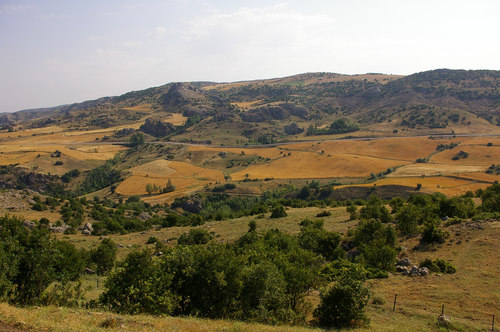 |
| And to think it's only 120 degrees there! Let's go streaking! |
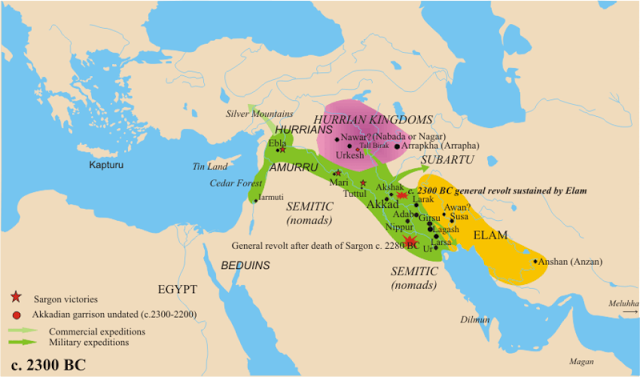 |
| Hurrians had a "moving" capitol because they chose to remain partly nomadic but realized the benefits of settlements. However, they only roamed a certain distance and then circled back around |
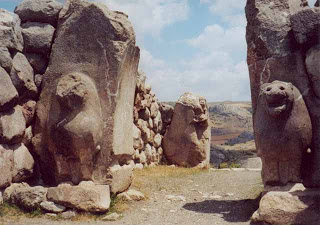 |
| Hattusas, the Hittite's first home, in Turkey |
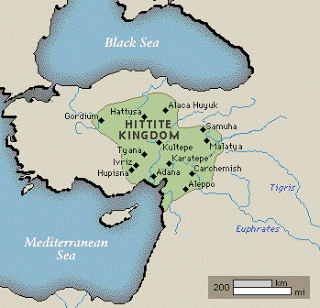 |
| This looks like a big territory, but it's covered in dry soil and steep hills |
-
The Hittites knew they were tricked and they pushed most everyone out of the better areas of Sumer, such as the capitol Akkad (Babylon), but they left shortly thereafter. This empty city allowed the Kassites to simply walk in and take these small places for their own after the Hittites left (Kassites are pre-Bedouins, some Kassites left later and called themselves the Bedouin/Amorites). The Hittites went back to Hattusas and decided never to make the mistake of ever leaving again, or hoping for a better life. This time, however, they did not leave for a long time. It wouldn't be until In the 14th century BC that the Hittite Kingdom would prosper as they had originally wished it to. Their future kingdom would span from Asia Minor (Turkey) to Sumer, which was very far away. Not only that, but they also took control of Syria all the way south to Ugarit. How did their luck suddenly change?
DEATH OF THE HURRIANS AND RISE OF THE HITTITES: The Hurrians are thought to have been slowly vanquished by other clashing peoples over a period of time. This slow-but-steady destruction is still thought to have been primarily carried out by the Assyrians located far north of the Sumerian cities. Assyrians are one of those cultures that seems to have been/incorporated many cultures. They simply went everywhere from Assyria to Babylon all the way to parts of the Jewish cultures and Egypt between the 9th through 5th centuries B.C.. It wouldn't be until later that the Assyrians would become the nefarious monsters that history knows them to be.
?
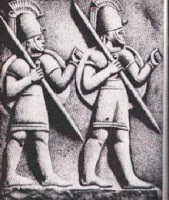 |
| 8 foot spear + stomach = mouchy |
-
The Hittites saw fit to preserve the Hurrians as military support because the of Assyrians ruled under King Ashur-uballit I around 1365 B.C. were encroaching on Hittite territory. As luck usually worked out for the Hittites, Ashur-uballit I attacked and managed to defeat Hurrian King Mattiwaza despite the attempts of Hittite king Suppiluliuma I to preserve the Hurrians as a buffer. The lands of the Mitanni and Hurrians were appropriated by Assyria, enabling it to encroach on Hittite territory near Asia Minor. Not far along the timeline, Assyrian king Adad-nirari I annexed Carchemish from the control of the Hittites, however events seem to pause after this, as if the Assyrians took a break from wearing out the Hittites.
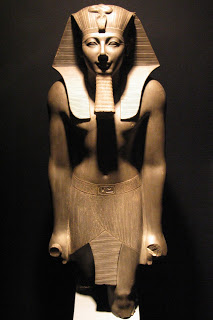 |
| Thutmose III |
-
The Egyptians, at about 1450-1425 B.C., went on and completed its conquering spree of almost the entire coast north of Egypt up to lower Syria, however, the Hittites had already seized control of the Hurrian territory which ranged from Sumer to northern Syria up to Hattusas (Turkey). Both cultures realized that neither of them desired conflict. The Egyptians were glad that the Hurrians were gone and had the Hittites to thank. With both sides realizing that no one wanted to fight, they decided to make a non-aggression treaty. A treaty whose "signature" was the marriage of the Hittite ruler's son to the widow of Pharaoh Tutankhamun, where Pharaoh Tut was assassinated in a conspiracy that no historian knows enough about to truly know the story in full. Around 1350 B.C., Hittite King Suppiluliuma I's son was also assassinated to prevent this marriage with the widow of Pharaoh Tut. The politics are convoluted, but it gets even worse. The widow also had motives of her own. It is said that she received a mysterious letter telling her she can be free from Egypt and escape marriage to the Hittite prince if she just met some unknown people at a specific location. She left and was never heard from again. What historians are left with now is an assassinated Hittite prince and an abducted Egyptian princess....both sides naturally have no clue of what was really going on and simply blame each other.
EGYPT AND HITTITES GO TO WAR: If you can't guess what happens next then you're obviously not a history buff. The two cultures broke out in war, but not just any war though, as this was the biggest war of the entire Bronze Age by far. Most of the Bronze Age wars had a few hundred to a couple thousand or so men. That's not very large, but keep in mind it wasn't too long ago that civilization was invented. Civilization is still a novelty at this point. However, the Hittite-Egyptian war is said to have had well over 25,000 men on each side, totaling as much as or beyond 50,000 warriors. Keep in mind that cities in this age had only a couple thousand people, some super-cities of the Bronze Age may have had close to 10,000 people. Where did all of these people come from?! Women did not fight in these days and neither did youth. These armies probably consisted of just about every able-bodied man from across the entire continent. It is thought, however, that they mostly wanted to intimidate each other by a show of possible force. Intimidation was the name of this game, but it escalated into a full scale war shortly thereafter.
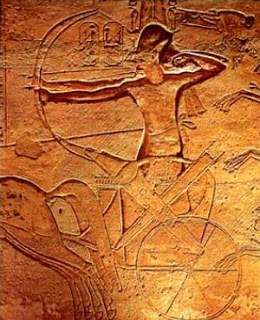 |
| The first drive by shooter...I'm serious |
BATTLE AT KADESH: After years and years of posturing and preparing, at about 1285 B.C. the famous Battle at Kadesh took place and it was truly a gruesome sight. There isn't a lot of information on the skirmishes and other battles, but this was the main event. The original King Suppiluliuma I and Egyptian King Rameses II had died year ago during all the preparing and posturing for war. In that time, a king for each of them came to power and passed on, and the war at Kadesh was fought by their grandchildren. They fought and killed and died by the thousands in fancy yet impractical chariots and on foot. It was a war more of "show" than of substance since both sides were too uncertain as to what they should do. None of them had ever really fought in a war. They butchered each other by the thousands until they realized they were both dying in droves equally. They drew up a peace treaty finally and....here's the irony....a prince on one side had to marry the princess on the other.... After all, that's how the entire mess began.
 |
| I like my definition better |
-
The end of the Hittite story can be summarized by:
Irony: when you try to sign a treaty with another cultural power but instead go to war over a misunderstanding only to sign the treaty anyway but only after slaughtering thousands yet when you get what you want you lose it all.
The End!
- 3000 Year Old Human Sculpture Discovered In Turkey
A beautiful and colossal human sculpture is one of the latest cultural treasures unearthed by an international team at the Tayinat Archaeological Project (TAP) excavation site in southeastern Turkey. A large semi-circular column base, ornately decorated...
- Archaeologists Uncover 3,000-year Old Lion
Archaeologists leading the University of Toronto?s Tayinat Archaeological Project in southeastern Turkey have unearthed the remains of a monumental gate complex adorned with stone sculptures, including a magnificently carved lion. The gate complex provided...
- The Ancient Republic Of Rome Part 3: Iulius Caesar And Pompey The Great
My other blogs are:http://religion-by-kyle.blogspot.comhttp://astronomy-by-kyle.blogspot.com??????The First Triumvirate Gaius Iulius Caesar Gnaeus Pompeius Magnus General Marcus Licinius Crassus The Ancient Republic of Rome Part 3Iulius Caesar, or better...
- The Origins Of The Persians And The Battle Of Marathon Against Ancient Greece
My other blogs are:http://religion-by-kyle.blogspot.comhttp://astronomy-by-kyle.blogspot.comThe Origins of the Persians and the Battle of Marathon Against Ancient Greece The Persians. Not the scariest name you've ever heard, especially...
- Of Minoans And Mycenaeans: The Rise And Fall Of Proto-greeks And End Of The Bronze Age
My other blogs are:http://religion-by-kyle.blogspot.comhttp://astronomy-by-kyle.blogspot.comOf Minoans and Mycenaeans The Rise and Fall of Proto-Greeks and the End of the Bronze AgeIt all started with the Minoans. Who were they though? Did they come for...
